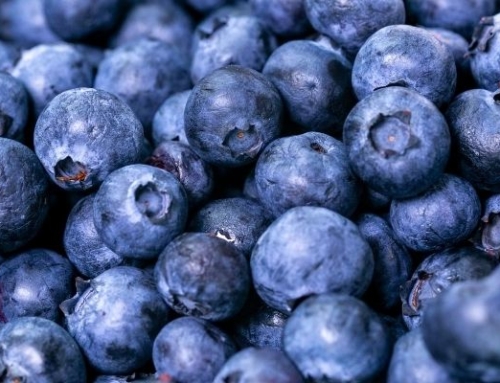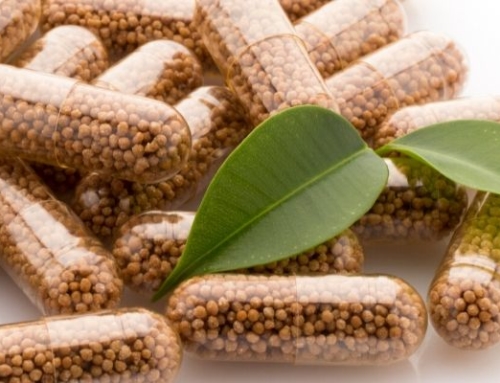Why Prebiotics & Probiotics together?

The role of the intestine is not limited to the assimilation of nutrients and the elimination of waste, but it extends to the protection of the whole body. Indeed, it provides an effective preservation against bacteria, viruses, toxic and allergens in the intestinal lumen, through three defensive lines: the intestinal flora, intestinal epithelium, and the intestinal immune system.
The role of the Intestinal Flora
Our intestines produce 70 to 85% of the immune cells of the organism and host 100 000 billion bacteria from 400 different species which compose the intestinal flora.
Among these bacteria, most are harmless or beneficial for the body. Under normal circumstances, other, potentially pathogenic, are too few to have an adverse effect. Indeed, by producing lactic acid, the “good” bacteria make the intestinal environment unfavorable to the development of pathogenic bacteria.
The bacteria of the intestinal flora feed on derived food unused by the body (fibers, cartilage, etc.) and play an important role:
– Digestion: The flora completes the food digestion by the fermentation process. It also participates to the digestive motility, in other words, the intestinal transit.
– Assimilation of nutrients.
– Elimination of waste: cholesterol uptake, elimination of toxic as ammonia, nitrites, etc.
– Barrier against infection: the bacteria of the intestinal flora stimulate macrophages and lymphocytes; these cells play a major role in the general immunity of our body.
But, any aggression to the intestinal flora can affect its balance and allow harmful bacteria to grow: stress, overuse of medication, unhealthy diet and/or low in fiber, infections, diseases, or taking antibiotics.
The enteric nervous system:
Studies conducted by Michael D. Gershon, a researcher at Columbia University, US, have shown that the enteric nervous system (intestinal), called also the second brains contains over 100 million neurons and secretes at least 20 neurotransmitters identical to those found in the brain. It participates in the management of our emotions and it is involved in pain control and regulation of thermoregulation, food, and sexual behavior, sleep-wake cycle, pain and anxiety.
In summary, our intestine is a key element for our health and mood. It is, therefore, important to maintain a rich and balanced intestinal flora.
Choose high-quality Probiotics and Prebiotics for a natural, fast and gentle action:
To ensure the good balance of our intestinal flora, nutritional supplements such as Probiotics and Prebiotics are particularly recommended.
Probiotics are micro-organisms ingested alive that colonize our digestive tract and allow friendly bacteria residing in the intestinal flora, to grow and “get over” the pathogenic bacteria. They help the intestinal flora to fulfill better its assimilation, digestion, and elimination1 functions. They also have a beneficial effect on the stimulation of the natural defenses, the state of stress and anxiety.
Prebiotics are nutrients that resist to the stages of digestion and intestinal absorption and are intended to feed certain bacteria. They favor the growth of beneficial bacteria over that of harmful ones.
The scientific observations show the beneficial effect of the Pro and Prebiotics combination and consider its superior action to those with the Probiotics only.
Four Probiotics to restore and balance the intestinal flora
Lactobacillus Rhamnosus
This bacterium has been the subject of considerable research. It is often used in dairy products in Finland and the US, where its virtues to enhance immunity are sought[2]:
– Lactobacillus rhamnosus protects against acute diarrhea[3] caused by viral gastroenteritis.
– Associated to Bifidobacterium longum, it proves a great efficiency to prevent Tousista – shown by numerous clinical[4] trials
– Associated with Bifidobacterium longum, it acts on the eradication of infections by the helical pylori – this latter being the cause of many gastritis and most peptic ulcers. In 2009, two meta-analyses have proven the effectiveness of probiotics to help cure this infection and mitigate its adverse effects[5,6].
– It improves the condition of people suffering from irritable bowel syndrome by alleviating pain, flatulence, bloating and regulating intestinal[7] transit.
– Lactobacillus rhamnosus reduces the protective layer in the intestines, especially in cases of alcohol[8] problems.
– It avoids complications due to taking an antibiotic[9] treatment.
– It has a powerful action on the vaginal infections, by intervening in the vaginal flora balance[10].
– Lactobacillus rhamnosus has significant impacts on anxiety and obesity by slowing the release of corticotropin-releasing hormones (CRH) that control the activity of the hypothalamic-pituitary-adrena axis[11].
Bifidobacterium Longum
Among the 400 species of bacteria of the intestinal flora, Bifidobacterium longum is one of the most common and most studied. It would constitute more than 95% of the intestinal flora of breastfed[12] infants, which would explain their greater resistance to infection.
Among its actions, it has been verified that:
– Associated with Lactobacillus rhamnosus, she proved great effectiveness to prevent the “turista” (see previous paragraph).
– Associated with Lactobacillus rhamnosus, it acts on the eradication of infections by the helico pylori (see previous paragraph).
– Bifidobacterium longum improves the condition of people suffering from irritable bowel syndrome[13].
– It relieves the symptoms of lactose intolerance[14].
– It calms the inflammation associated with Crohn’s disease or colitis.
– It prevents relapses of ulcerative colitis by extending remissions[15].
– Lactic acid produced by Bifidobacterium longum has anti-carcinogenic and anti-mutagenic properties. Studies have proven its effects on tumor[16].
Lactobacillus Acidophilus
This bacterium was isolated, in 1900, in the faeces of infants and named Bacillus acidophilus because of its remarkable tolerance to acidity.
It has many properties:
– A proven effectiveness in preventing diarrhea caused by antibiotics, in combination with Bifidobacterium longum.
– Lactobacillus acidiphilus specifically attenuates intestinal problems caused by anxiety[17].
– It has been proven it has an antagonistic activity against pathogens of food products such as Staphylococcus aureus, Salmonella typhimurium, Escherichia coli and Clostridium perfringens[18].
– It is known to have the ability to metabolize lactose in the small intestine and thus facilitate its digestion[19].
– It is anti-carcinogenic. An experiment conducted in rats shows a lower incidence of colon cancer after a period of 20 weeks, with the administration of the bacteria[20].
– It easily adheres to the wall of the intestine, which facilitates its implantation in a cure of probiotics[21].
– Finally, Bacillus acidophilus can treat or prevent vaginal infections. In 2009, researchers have compared the effectiveness of various treatments against bacterial vaginosis, one of the most common causes of vaginitis[22]. They concluded that the local use of lactobacilli is more effective than antibiotics prescribed orally (clindamycin, metronidazole).
Bifidobacterium Infantis
This strain of bacteria is acquired naturally during childbirth and then with breastfeeding[23], which would explain the greater resistance to infections in breastfed infants[24].
Irritable bowel syndrome is accompanied by a significant reduction in the amount of intraluminal bifidobacteria, with consequences such as colic gas production and impaired motility of the intestinal tract.
Ingesting a probiotic complement of the Bifidobacterium Infantis strain allows to re-seed good bacteria and to act effectively and without side effects for:
– Reduce pain due to irritable bowel syndrome. Indeed, it has been demonstrated, for example, that a complex of Bifidobacterium Infantis and Longum is associated with better control of intestinal pain and improves quality of life compared to placebo in children with SCI[25]
– Decrease “bloating” which is particularly difficult to treat and often categorized as the most intrusive symptom by those affected by SCI[26],
– Normalize intestinal transit and cause overall relief in patients with SCI,
– Act on the psychological factors of the SCI: Bifidobacterium Infantis is considered as a “psychobiotic”, with anti-inflammatory actions and a real ability to reduce the activity of the hypothalamic-pituitary-adrenal axis which maintains the capacity of the organism to respond to acute and prolonged stressors. Results of large-scale placebo-controlled studies are expected[27].
Two Prebiotics to reinforce the action of the Probiotics
Fructo Oligo Saccharides (FOS)
Prebiotics are non-assimilable carbohydrate by the body whose ingestion induces major changes in the intestinal flora, characterized by an increase in colonies of bifidobacteria and a decrease of those pathogenic bacteria.
The FOS are short-chain carbohydrates with these virtues:
– They are immunomodulators: by increasing the colonies of bifidobacteria[28], they allow the activation of lymphocytes and macrophages, the production of antibodies (sIgA) and finally increase the resistance to infections by pathogenic organisms. They, therefore, maintain the intestinal immune system (IBS).
– They act on the stimulation of the short-chain fatty acids (SCFA) synthesis: the water content in the colonic contents being increased, which eventually increases stool weight and softens consistency[29].
– They induce a decrease in the pH of the colon, enhance the intestinal absorption of certain minerals, such as calcium and magnesium, and of certain substances, such as isoflavones, acting on bone[30]mineral density.
– They limit the formation of carcinogens. Prebiotics can also prevent degradation of the genistein known for its anti-cancer[32] effects.
– Finally, the FOS are relevant for the infant’s nutrition and young children, in the absence or after the breastfeeding interruption.
Taking Prebiotics as a supplement, in the form of Fructooligosaccharides, therefore provides real health benefits, well beyond actions on digestive discomfort.
Ribose
Ribose is a sugar useful to all living organisms. It plays three major roles:
– It is a component of adenosine triphosphate (ATP), the fuel of cell that meets the body’s energy needs.
– It has an action on the UTP (Uridine triphosphate): a compound that provides energy, helps the muscle recovery and promotes the synthesis of glycogen.
– It enables the production of ribonucleic acid (RNA) for the transcription of the genetic[33] code.
Ribose is therefore particularly important to stimulate all the body and reinforce the bacteria in the intestinal flora.
– It is composed of a studied mixture of three different Probiotics for further action and a full and rapid colonization of the intestine,
– To these Probiotics are associated two Prebiotics to reinforce their action, this complex contains strains recognized for their effectiveness and their complementary action,
– It reinforces the immune system,
– It improves the transit
– It restores the intestinal flora,
– It reduces the recurrence of vaginal mycoses,
– It helps to prevent the “turista” 15 days to 1 month before the trip,
– It avoids the undesirable effects of a long antibiotic therapy,
– The excellent tolerance achieved through the synergy of these components allows being used in the long term without side effects,
– It works by “Sustained release” to pass the gastric barrier,
– It is made from 100% natural active, with a “smart” formulation for a synergistic and effective action of the components,
– It is completely bioavailable,
– Biocompatible, it respects the body and acts in depth on our vitality.
Sources:
[1] Haddad PS, Azar GA, et al. Natural health products, modulation of immune function and prevention of chronic diseases. Evid Based Complement Alternat Med. 2005 Dec;2(4):513-20. Full text: http://ecam.oxfordjournals.org
[2] Doctissimo.fr website accessed September 11, 2014 « Il y a probiotiques et probiotiques »
[3] Szajewska H, Mrukowicz JZ. Probiotics in the treatment and prevention of acute infectious diarrhea in infants and children: a systematic review of published randomized, double-blind, placebo-controlled trials. J Pediatr Gastroenterol Nutr. 2001 Oct;33 Suppl 2:S17-25.
[4] McFarland LV. Meta-analysis of probiotics for the prevention of traveler’s diarrhea. Travel Med Infect Dis. 2007 Mar;5(2):97-105. Epub 2005 Dec 5.
[5] Sachdeva A, Nagpal J. Effect of fermented milk-based probiotic preparations on Helicobacter pylori eradication: a systematic review and meta-analysis of randomized-controlled trials. Eur J Gastroenterol Hepatol. 2009 Jan;21(1):45-53.
[6] Zou J, Dong J, Yu X. Meta-analysis: Lactobacillus containing quadruple t! herapy versus standard triple first-line therapy for Helicobacter pylori eradication. Helicobacter. 2009 Oct;14(5):97-107.
[7] Nikfar S, Rahimi R, et al. Efficacy of probiotics in irritable bowel syndrome: a meta-analysis of randomized, controlled trials. Dis Colon Rectum. 2008 Dec;51(12):1775-80. Epub 2008 May 9.
[8] Wang, Y.; Liu, Y.; Sidhu, A.; Ma, Z.; McClain, C.; Feng, W. Lactobacillus rhamnosus GG culture supernatant ameliorates acute alcohol-induced intestinal permeability and liver injury. Am J Physiol Gastrointest Liver Physiol 303 (1): G32–41. doi:10.1152/ajpgi.00024.2012. PMID 22538402. Forsyth, CB.; Farhadi, A.; Jakate, SM.; Tang, Y.; Shaikh, M.; Keshavarzian, A. (Mar 2009). Lactobacillus GG treatment ameliorates alcohol-induced intestinal oxidative stress, gut leakiness, and liver injury in a rat model of alcoholic steatohepatitis. Alcohol 43 (2): 163–72. doi:10.1016/j.alcohol.2008.12.009. PMID 19251117.
[9] McFarland LV. Meta-analysis of probiotics for the prevention of antibiotic associated diarrhea and the treatment of Clostridium difficile disease. Am J Gastroenterol. 2006 Apr;101(4):812-22. http://www.ncbi.nlm.nih.gov/pubmed/16635227
[10] Oduyebo OO, Anorlu RI, Ogunsola FT. The effects of antimicrobial therapy on bacterial vaginosis in non-pregnant women. Cochrane Database Syst Rev. 2009 Jul 8;(3):CD006055. Revi! ew. http://www.ncbi.nlm.nih.gov/pubmed/19588379
[11] Alison C Bested, Alan C Logan, Eva M Selhub. Intestinal microbiota, probiotics and mental health: from Metchnikoff to modern advances: part III – convergence toward clinical trials. Gut Pathog. 2013; 5: 4. Published online 2013 March 16. doi: 10.1186/1757-4749-5-4 http://www.ncbi.nlm.nih.gov/pmc/articles/PMC3605358/
[12] Yoshioka H. et al., Development of the normal intestinal flora and its clinical significance in infants and children, Bifidobacteria and Microflora, 1991, 10(1): 11-17.
[13] Nikfar S, Rahimi R, et al. Efficacy of probiotics in irritable bowel syndrome: a meta-analysis of randomized, controlled trials. Dis Colon Rectum. 2008 Dec;51(12):1775-80. Epub 2008 May 9.
[14] He T1, Priebe MG, Zhong Y, Huang C, Harmsen HJ, Raangs GC, Antoine JM, Welling GW, Vonk RJ. Effects of yogurt and bifidobacteria supplementation on the colonic microbiota in lactose-intolerant subjects. J Appl Microbiol. 2008 Feb;104(2):595-604. Epub 2007 Oct 9. http://www.ncbi.nlm.nih.gov/pubmed/17927751.
[15] Sang LX, Chang B, et al. Remission induction and maintenance effect of probiotics on ulcerative colitis: a meta-analysis. World JGastroenterol. 2010 Apr 21;16(15):1908-15. http://www.ncbi.nlm.nih.gov/pubmed/20397271
[16] Benno, Y.; Mitsuoka, T. (1992). Impact of Bifidobacterium longum on human fecal microflora. Microbiology and immunology 36 (7): 683–694
[17] Diop L, Probiotic food supplement reduces stress-induced gastrointestinal symptoms in volunteers: a double-blind, placebo-controlled, randomized trial, Nutr Res. 2008 Jan;28(1):1-5. doi: 10.1016/j.nutres.2007.10.001
[18] M.E. Sanders, Invited Review: The Scientific Basis of Lactobacillus acidophilus NCFM Functionality as a Probiotic, Journal of Dairy Science, vol. 84, no 2, 2001-02, p. 319-331 ISSN 0022-0302, DOI 10.3168/jds.S0022-0302(01)74481-5
[19] R G Montes, Effect of milks inoculated with Lactobacillus acidophilus or a yogurt starter culture in lactose-maldigesting children, Journal of dairy science, vol. 78, no 8, 1995-08, p. 1657-1664 (ISSN 0022-0302, DOI 10.3168/jds.S0022-0302(95)76790-X)
[20] B R Goldin, Alt! erations of the intestinal microflora by diet, oral antibiotics, and Lactobacillus: decreased production of free amines from aromatic nitro compounds, azo dyes, and glucuronides, Journal of the National Cancer Institute, vol. 73, no 3, 1984-09, p. 689-695 (ISSN 0027-8874)
[21] Site de Opticbac Probiotics, What is acidophilus
[22] Oduyebo OO, Anorlu RI, Ogunsola FT. Cochrane Database Syst Rev. 2009 Jul. The effects of antimicrobial therapy on bacterial vaginosis in non-pregnant women. 8;(3):CD006055. Review.
[23] Mark A. Underwood, J. Bruce German, Carlito B. Lebrilla, David A. Mills. Bifidobacterium longum subspecies infantis: champion colonizer of the infant gut. Pediatr Res. Author manuscript; available in PMC 2015 March 5. Étude ici
[24] Yoshioka H. et al., Development of the normal intestinal flora and its clinical significance in infants and children, Bifidobacteria and Microflora, 1991, 10(1): 11-17.
[25] https://www.ncbi.nlm.nih.gov/pubmed/27306945
[26] Nikfar 171
[27] https://www.ncbi.nlm.nih.gov/pubmed/23759244
[28] Mao B, D Li, Zhao J, Liu X, Gu Z, Chen YQ, Zhang H, Chen W. Métagénomique Regards sur les Effets des fructo-oligosaccharides (FOS) sur la composition du microbiote fécal chez la souris. J Agric Food Chem . 28 janvier 2015; 63 (3): 856-63. doi: 10.1021 / jf505156h. Epub 2015 le 17 janvier. http://www.ncbi.nlm.nih.gov/pubmed/25598242
[29] Moro G, Minoli I, Mosca M et al. Dosage-related bifidogenic effects of galacto- and fructooligosaccharides in formula-fed term infants JPGN 2002; 34: 291–295
[30] Miller TL, Wolin MJ. Pathways of acetate, propionate, and butyrate formation by the human fecal microbial flora. Appl Environ Microbiol 1996; 62: 1589–92!
[31]1Bruno-Barcena JM, Azcarate-Peril MA. Galacto-oligosaccharides and Colorectal Cancer: Feeding our Intestinal Probiome. J Funct Foods. 2015 Jan;12:92-108. PMID: 25584074 [PubMed] http://www.ncbi.nlm.nih.gov/pubmed/25584074
[32] Steer TE1, Johnson IT, Gee JM, Gibson GR. Metabolism of the soybean isoflavone glycoside genistin in vitro by human gut bacteria and the effect of prebiotics. http://www.ncbi.nlm.nih.gov/pubmed/13129470
[33] Masantenaturelle.com website accessed September 11, 2014, une seconde vie grâce au Ribose
Images Credit: DepositPhotos





